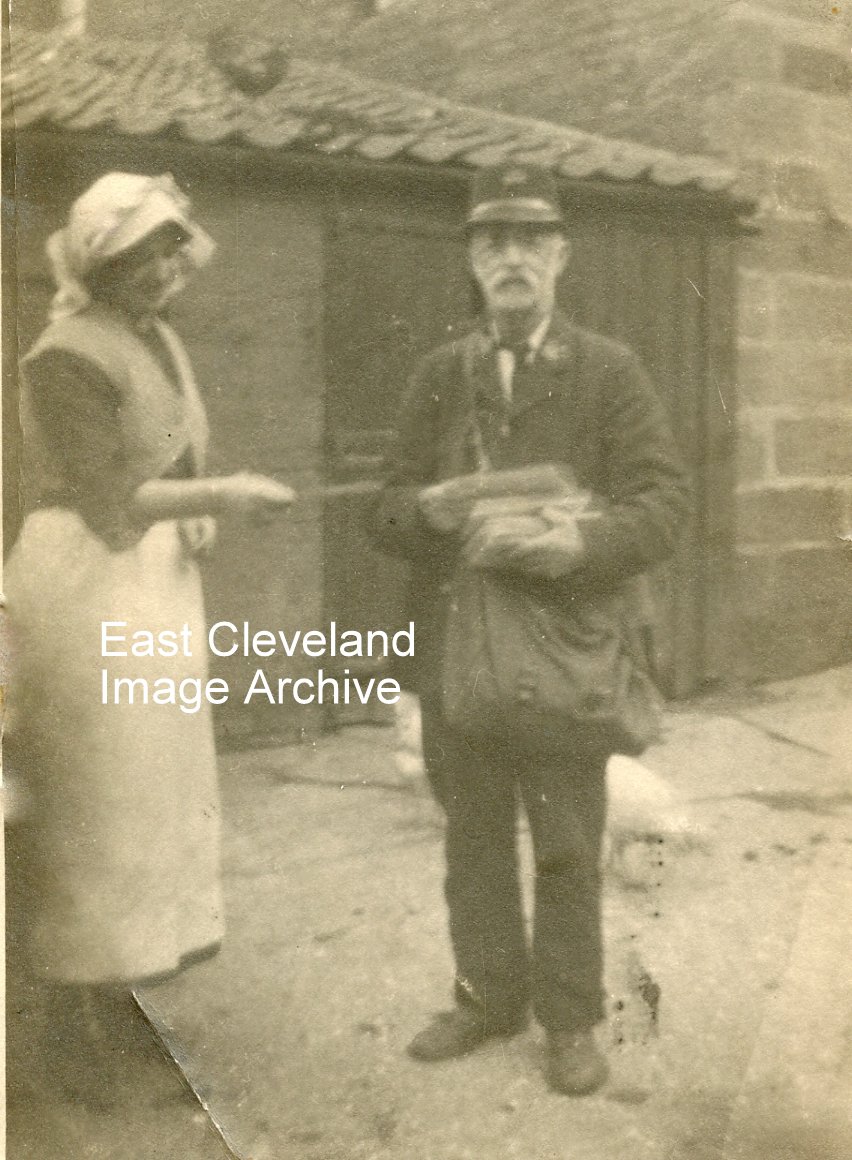
After featuring the postman handing mail to Mary Bennison in this photograph, taken in 1922; we were told by Pauline Morrell: “This is Thomas Hansell my great grandad.”
Image courtesy of Mr. Ray Conn and thanks to Pauline Morrell for the update.
|
|
||
|
After featuring the postman handing mail to Mary Bennison in this photograph, taken in 1922; we were told by Pauline Morrell: “This is Thomas Hansell my great grandad.” Image courtesy of Mr. Ray Conn and thanks to Pauline Morrell for the update.
Mr. Bennison, John Dowey and Mr. Manning Robert Russell sitting on the bench outside the Institute at Boulby ’Tin City’. John Russell tells us: ”The gentleman sitting at the right hand end of the bench is my great grandfather Manning Robert Russell (1852 – 1936). He originated from Brigstock in Northamptonshire and after a few years working in the Durham collieries worked as a under-manager at a Boulby Ironstone Mine from 1908 – 1927. Any further information or memories would be very welcome.” Image courtesy of Mr. Ray Conn and many thanks to John Russell for the update.
Ray Conn’s grandparents; Katie and Stephen Wilkinson Easton, standing in front of one of the cottages at Boulby in 1918. Ray has told us that Stephen Wilkinson Easton carved his initials; S.W.E. on a stone at the quarry and it is still there. Vivienne Story (nee Easton) tells us: ” Kate and Stephen I believe are my Great Grand Parents.” Image and information courtesy of Mr. Ray Conn and many thanks to Vivienne Story for the update.
Ray Conn’s parents; Margaret and Norman Bennison Conn, at Boulby Cottages. Image courtesy of Mr. Ray Conn.
Grandmother Katie Easton holding a very young Ray Conn at 6 Boulby Cottages. The cottages, known locally as Tin City, were listed in the 1911 census as Iron Cottages. They were built by Skinningrove Iron Company to house the miners working at the Boulby Ironstone Mine. The first ones were occupied by the end of 1906. They were semi-detached bungalows built from corrugated iron sheeting on timber frames, standing on concrete foundations. The Boulby Mine finally closed in 1934 and in October 1936 The Ministry of Health issued a demolition order as part of a ”slum clearance scheme”; much to the residents displeasure. Over the next few years the tenants moved out and the cottages were demolished. Ray Conn has told us that tin sheets and timber went to Wards Farm at Roxby and were used to build a large shed. Anthony Mugfordf tells us: “I discovered a relative – Thomas Mugford – who was an ironstone miner, who lived with his family at number 8. There was Thomas, wife Gertrude, adult son Thomas and children Gertrud, Dora, Florence, Lavinia and Hilda.” Image courtesy of Mr. Ray Conn, additional information courtesy of cuttings from Northern Echo 24th October 1937 and materials courtesy of Eric Jackson; also to Anthony Mugford for the update.
’Old’ Mr Newton at the rear of the ’Tin City’ cottages. The bungalows had wash-houses at the back with coppers for heating the water. Two of them can be seen on the right of the picture. Image courtesy of Mr. Ray Conn.
We can identify all the men in this photograph: George Rawson, Dennis Bowman, Rev. Johnson, Harry Dack, Mr Keen, Herbert Stephenson, Bob MacLean (foreman), Stan Downes, George Gettings, Arthur Ransome.Phil Ransom told us: “Full line up, according to Mother is – George Rawson, Dennis Bowman, Rev Johnson, Harry Dack, Mr. Keen, Herbert Stevenson, Bob McLean (foreman), Stan Downs, George Gettings, Arthur Ransome. The picture is taken in Skinningrove Square where a church was to be built and this voluntary work was undertaken by the ‘brick gang’; apparently the project was stopped due to lack of money.” Derick Pearson added: “The fact that Reverend Johnson and Bob McLean were there might give an indication to what the event was and where; Herbert Stephenson was a Sample passer on the works and so would assume he was acting as a labourer here to the bricklayers.This must have been some voluntary event.” Arthur Ransome started work as a bricklayer at the Skinningrove Works when he was 14 in 1947, but left the works in the early 70’s when steel production stopped and continued as a bricklayer building many houses in the local area. The bricks in front of them could be fire bricks that were used to line the furnaces, although the ‘brick gang’ would be called upon to carry out all kinds of building work. Image from a compilation by Derick Pearson , also thanks to Derick Pearson and Philip Ransome for the information regarding this Skinningrove event.
The Archive understands this is an image members of the Hall family from Carlin How. Can anybody else assist with details? Image from a compilation by Derick Pearson.
An early picture of partially blind Mr Jacobs of Carlin How Dairy, in later life Mr Jacobs became almost totally blind, but continued to successfully run his Dairy on Brotton Road. Image from a collection compiled by Derick Pearson.
Our image portrays an occassion celebrated by Pheobe and friends. Some of whom have been identified, but we still await advice on where and why. Back row: Audrey Medcalf, ??, Mrs Dredge, ??. Front row: ??, Phoebe Dack, Mrs Briggs, Marion Barwick(nee Ditchburn), ??. Geoff tells us ”Lady fourth from left bottom row is Marion Barwick (nee Ditchburn), my mother in law’s mother, no idea what the occasion is though”. Lady in middle of front row now identified by Margaret Snowdon as Mrs Briggs who lived in Gladstone Street. Image from a collection compiled by Derick Pearson, thanks to Derick, Geoff and Margaret Snowdon (Raspison) for the updates. |
||
Recent Comments